Asus ROG MATRIX 7970 3 GB Graphics Card Review

New Asus graphics accelerator can be called a true apogee of the Radeon HD 7970 evolution. It is hard to believe that there could ever be any faster or more advanced graphics accelerators before the HD 7000-series epoch comes to its logical end.
AMD’s Tahiti GPUs from the Southern Islands family were announced about a year and a half ago, but AMD seems to be in no hurry with new releases. Well, it doesn’t have to, actually, because AMD-based products look competitive against their Nvidia-based counterparts in every price segment. So, AMD partners have nothing left to do but polish off their solutions and offer something special like the recently released ASUS ROG Matrix 7970. Designed for extreme overclockers and stuffed with various technologies, it is in fact the fastest Radeon HD 7970 GHz Edition available right now. We’ll check out its features and benchmark its performance in our today’s review.
Technical SpecificationsThe technical specifications of ASUS ROG MATRIX 7970 are listed in the following table in comparison with those of the AMD Radeon HD 7970 GHz Edition and NVIDIA GeForce GTX 680:
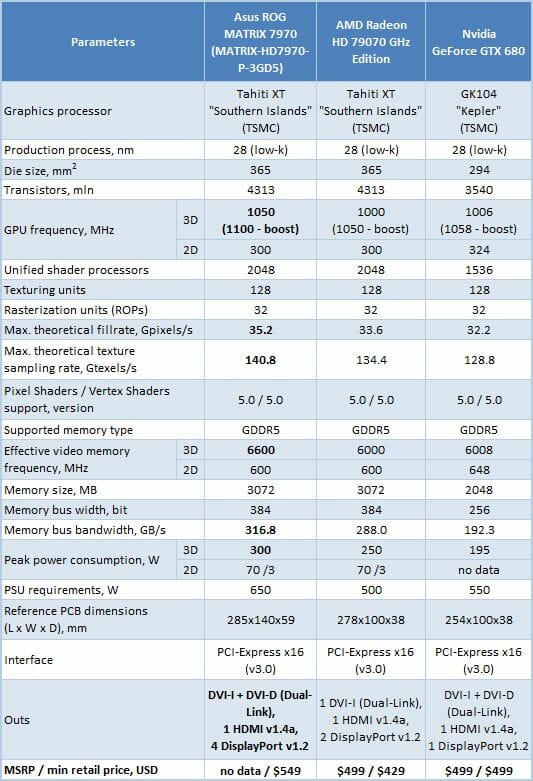
Packaging and Accessories
The cardboard box with the ASUS ROG Matrix 7970 is as large as typical mainboard boxes:
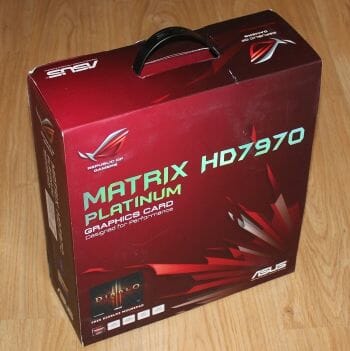
So, there’s a lot of text on the packaging describing the product and technologies implemented in it.
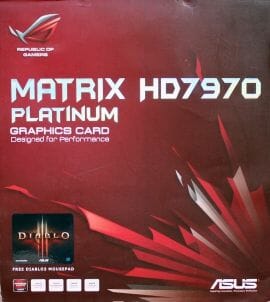
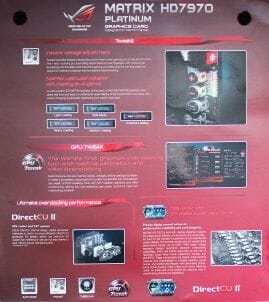
The top flap can be opened to reveal even more information about the ASUS ROG Matrix 7970 and to take a look at the graphics card itself through a plastic window.
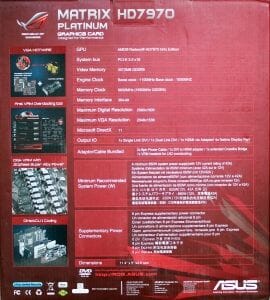
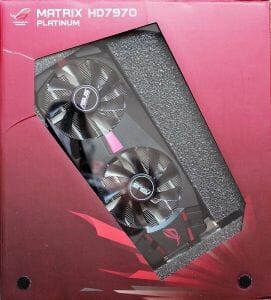
There are a lot of accessories inside: a power cable, DVI->HDMI and DVI->VGA adapters, a CrossFireX bridge, a VGA Hotwire cable for connecting the card to ROG series mainboards, an alternative voltage regulator heatsink, a ROG sticker, and a CD with drivers and utilities.
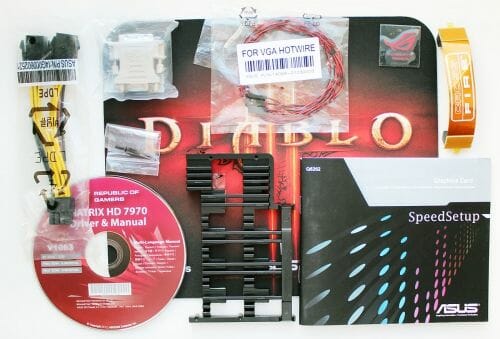
As a nice bonus, a Diablo 3 mouse pad is in the box although there are no games included. Manufactured in China, the ASUS ROG Matrix 7970 comes into retail at $549 with a 3-year warranty.
PCB Design and Functionality
The ASUS ROG Matrix 7970 can impress anyone with its looks. The matte black casing of its cooler with red inserts and two large fans makes it very stylish.
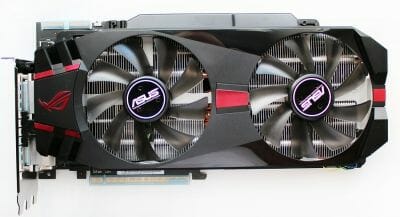
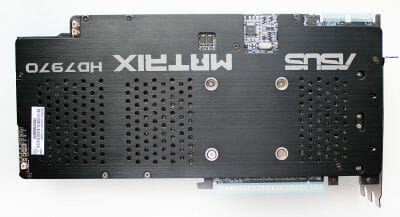
The reverse side of the PCB is covered with a perforated metallic plate on which you can read the name of the model. The word “Matrix” on the top edge of the card is highlighted:
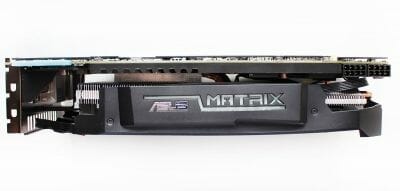
The device is 285x140x59 mm large, so it is going to take three PCIe slots on your mainboard. It is also recommended to leave a fourth slot free for the card’s cooler to work efficiently.
The card’s mounting bracket is an epic view with two DVI connectors and as many as four DisplayPorts. You can connect up to six monitors to it concurrently but there are certain nuances. You can use only one DVI in dual-link mode together with one DisplayPort or you can use two DVI ports in single-link mode and enable all four DisplayPorts.
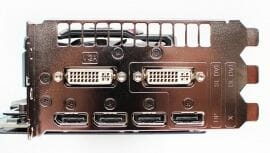
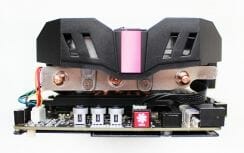
The operation mode of the video ports is specified by means of a small BIOS switch you can find near the CrossFireX MIO connectors. Three small buttons can be spotted at the other side of the PCB – we’ll explain their purpose shortly. There is also a switch that makes fans work at their maximum speed.
Instead of one 6-pin and one 8-pin power connector, the ASUS ROG Matrix 7970 is equipped with two 8-pin connectors:
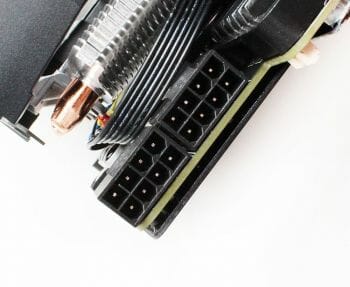
It might be expected since the ASUS ROG Matrix 7970 is specified to consume up to 300 watts, which is 50 watts more than specified for the reference AMD Radeon HD 7970 GHz Edition. A 650-watt PSU is recommended for a computer with one ROG Matrix 7970 inside.
Two MIO connectors for building CrossFireX configurations can be found in their conventional place. The switch you use to select the operation mode of the card’s video outputs can be seen in the photo, too:
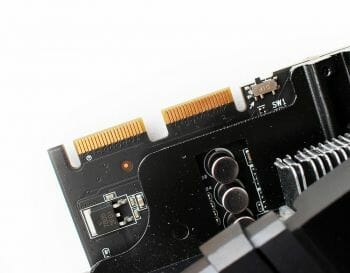
Considering the triple-slot form-factor, the ASUS ROG Matrix 7970 can hardly be used in CrossFireX configurations with more than one additional card.
Having removed the cooler, we found the PCB to be mostly covered by a metallic heatsink plate with some finning.
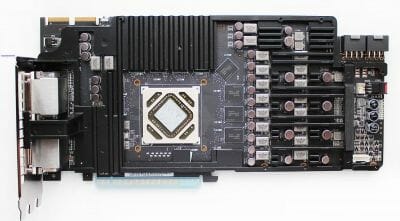
It is responsible for cooling power system components and some memory chips. There’s an additional heat-spreading plate among the accessories which is used if the card is cooled by liquid nitrogen or freon-based coolers.
The ASUS ROG Matrix 7970 features a custom PCB with high-quality and durable components (ASUS Super Alloy Power technology). The GPU voltage regulator has as many as 16 phases and is managed by a digital controller DIGI+ ASP1211. There are four phases for the memory chips and other circuitry, so the total number of power phases is 20. The iROG chip installed in the top part of the PCB seems to be responsible for communication between the graphics card and ROG series mainboards from ASUS via the VGA Hotwire interface.
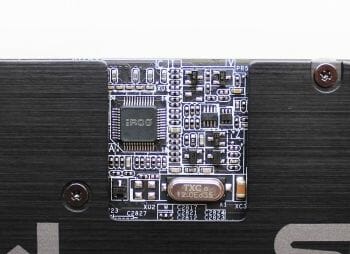
It offers you hardware control over all of the graphics card parameters via the UEFI BIOS or ASUS AI Suite software.
There are three buttons next to the turbo switch for the cooler’s fans.
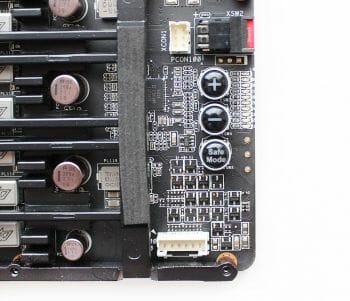
The “+” and “-” buttons can be pressed for step-by-step voltage adjustment even when the graphics card is up and running – the process is accompanied with colorful indication. Pressing the Safe Mode button makes the graphics card reset and restart with its default settings.
Hardcore overclockers may appreciate the contacts and connectors they can use to measure and increase voltages and enable LN2 mode.
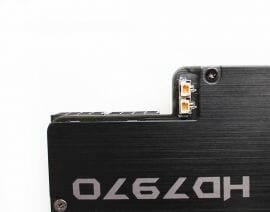
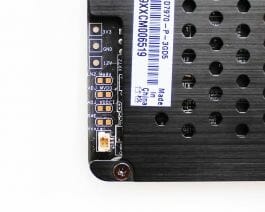
Overall, the ASUS ROG Matrix 7970 is not just a very fast graphics card, but a perfect tool for anyone who is into extreme overclocking.
Its Tahiti TX chip is quite ordinary:
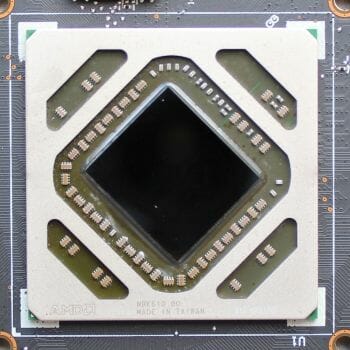
It has standard specifications save for clock rate. The latter is increased from 1050 to 1100 MHz. The specifications suggest that this is the boost clock rate, but the card actually works at 1100 MHz all the time in 3D applications, not only at high loads. So, we can assume that 1100 MHz is indeed the default GPU clock rate of the ASUS ROG Matrix 7970’s GPU in 3D applications.
The card is equipped with 3 gigabytes of GDDR5 memory in Hynix Semiconductor H5GQ2H24AFR R0C chips.
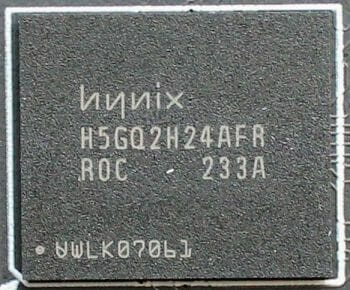
The memory chips are rated for 6000 MHz, but ASUS pre-overclocked it by 10%, up to 6600 MHz. Thus, the ASUS ROG Matrix 7970 is indeed the fastest serially manufactured Radeon HD 7970.
Here is a summary of the graphics card’s specifications:
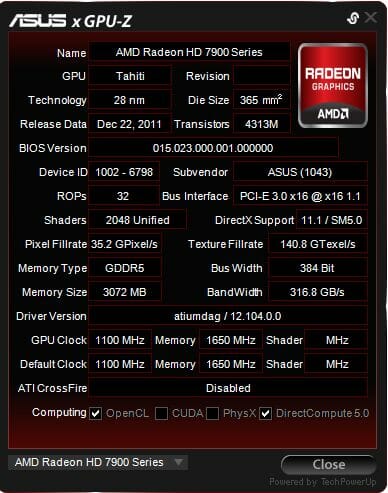
Cooling System: Performance and Noise Level
You may be already familiar with the ASUS DirectCU II cooler from our earlier reviews. It is installed on graphics cards of different levels, not only top-end ones, by the way. The ASUS ROG Matrix 7970 features one of its versions with five heat pipes, three of which are 8 mm in diameter and two are 6 mm in diameter. The aluminum heatsink consists of two sections and is covered with a metallic casing with fans.
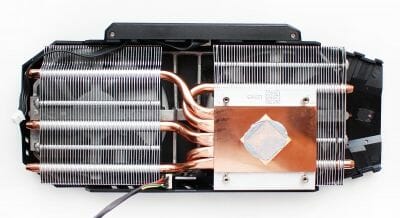
The fans are 100 mm in diameter and support PWM-based regulation. Taking the cooler apart further would spoil the casing (we’d have had to unglue the decorative inserts in it), so we only show you a photo of the contact spot of the cooler’s copper base:
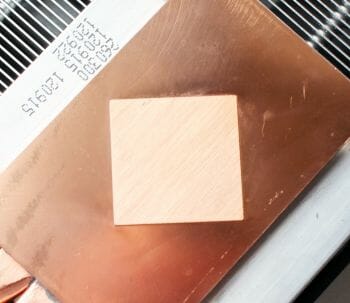
To test the cooler efficiency we are going to use five consecutive runs of a pretty resource-consuming Aliens vs. Predator (2010) game with the highest image quality settings in 2560×1440 resolution with 16x anisotropic filtering and MSAA 4x antialiasing. We used MSI Afterburner 3.0.0 beta 9 and GPU-Z version 0.7.0-0.7.1 for monitoring of temperatures and other parameters. All tests were performed inside a closed system case at 25°C room temperature.
Let’s see how efficient the DirectCU II is on the ASUS ROG Matrix 7970:
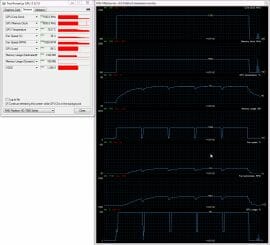
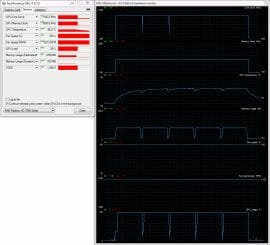
With the fans regulated automatically, the GPU was only 70°C hot and the peak speed of the fans was 1900 RPM. Considering the increased GPU frequency, the result is just excellent. At the maximum speed of the fans (3200 RPM), the GPU was a mere 4°C colder, so there is no point in accelerating the fans.
The ASUS ROG Matrix 7970 has a handy Matrix LED Load Indicator in its top part:
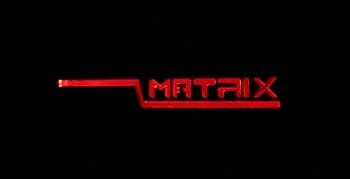
Depending on GPU load, this indicator changes its color into one of five variants:
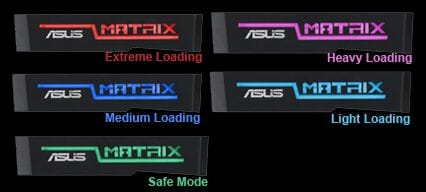
So you can easily monitor your graphics load in a visual way. The indicator looks quite attractive, too.
The noise level of each cooler was measured between 1:00 and 3:00 AM in a closed room about 20 m2 big using CENTER-321 electronic noise meter. The noise level for each cooler was tested outside the system case when the only noise sources in the lab were the cooler and its fan. The noise meter was installed on a tripod and was always at a 150 mm distance from the cooler fan rotor. The tested cooling systems were placed at the edge of the desk on a sheet of polyurethane foam. The lowest noise reading our noise meter device can register is 29.8 dBA and the subjectively comfortable noise level in these testing conditions was around 36 dBA (do not mix it up with low noise level). The fan(s) rotation speed was adjusted in the entire supported range using our in-house controller by changing the voltage with 0.5 V increment.
To estimate the level of noise generated by the ASUS ROG MATRIX 7970 cooler we also included the acoustic measurements HIS 7970 IceQ X² GHz Edition, ASUS GeForce GTX 680 DirectCU II TOP and reference AMD Radeon HD 7970 GHz Edition graphics card. Let’s see what we ended up with:
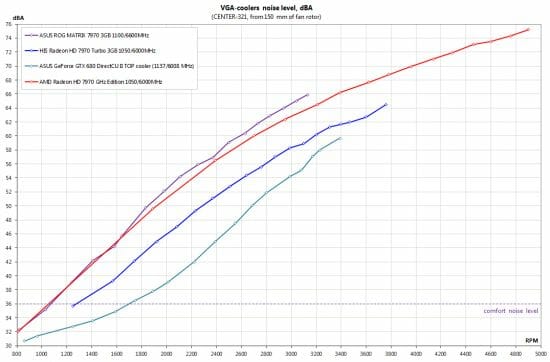
Unfortunately, the ASUS ROG Matrix 7970 isn’t as good in terms of noise level as in terms of temperature. In fact, the ASUS is no quieter than the reference AMD Radeon HD 7970 GHz Edition, which is considered very noisy. It is also odd that it is inferior to the ASUS GeForce GTX 680 DirectCU II TOP that uses almost the same cooling system. It is only thanks to lower fan speed that the ASUS ROG Matrix 7970 is quieter than the AMD Radeon HD 7970 GHz Edition. And it only remains quiet or comfortable in 2D applications.
Overclocking Potential
Having installed the graphics card on our mainboard, we found the latter to be unable to start up. The BIOS was initialized so we could even enter its interface, but after that we could see nothing but “0_” on a black screen. We solved the problem by using another BIOS. There were as many as five versions for the ASUS ROG Matrix 7970 at www.techpowerup.com and we chose this one. This must have been a compatibility issue between the graphics card and the Intel Siler DX79SR mainboard, but our solution may help someone else.
Before we proceed to testing the graphics card’s overclocking potential, we want to tell you about the exclusive GPU Tweak utility. Unlike MSI Afterburner, it can be used to monitor and tweak any graphics card parameters. Besides clock rates, you can change three voltages:
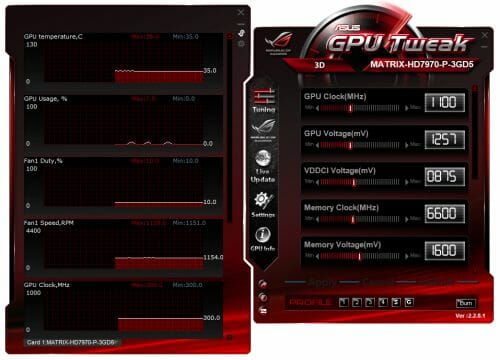
You can change the speed of each fan individually, specify a Power Target, and increase Load Line Calibration and VRM frequency parameters.
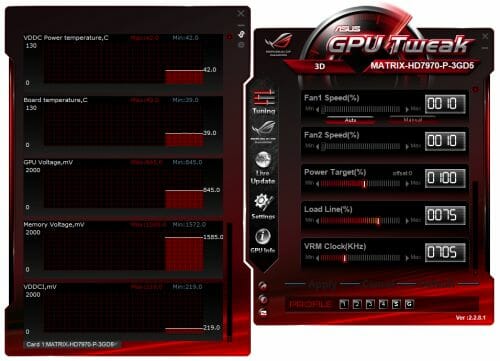
Of course, each of these and many other parameters can be monitored in the utility’s other window, which is very convenient.
GPU Tweak overclocks the GPU in an unusual way. For example, when we increased the GPU clock rate to 1200 MHz on our ASUS ROG Matrix 7970, the utility automatically changed its voltage, into 1.319 volts in our case:
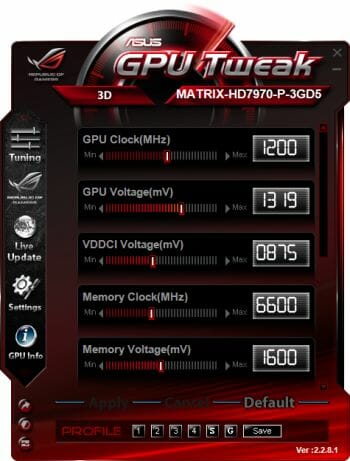
Then, if the GPU clock rate is increased to 1250 MHz, the voltage is set at 1.345 volts:
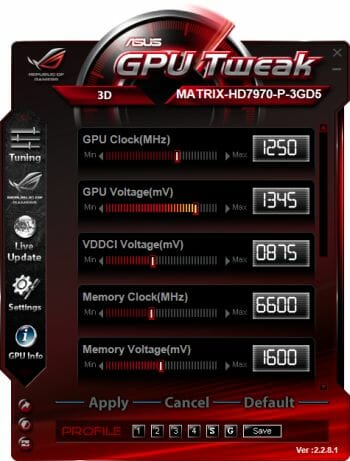
At 1340 MHz, the voltage is as high as 1.4 volts:
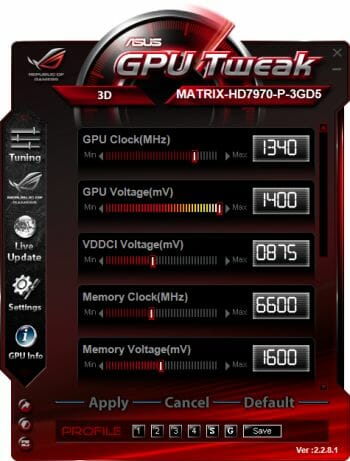
The correlation between frequency and voltage can be disabled in the utility’s settings, but we first tried to use the default ones. This approach wasn’t successful, though. The graphics card would pass our tests, but showed visual artifacts. So, we had to rely on our traditional method and find the highest stable clock rates without any voltage modification. At its default voltage the GPU was stable at 1160 MHz and the graphics memory at 7080 MHz.
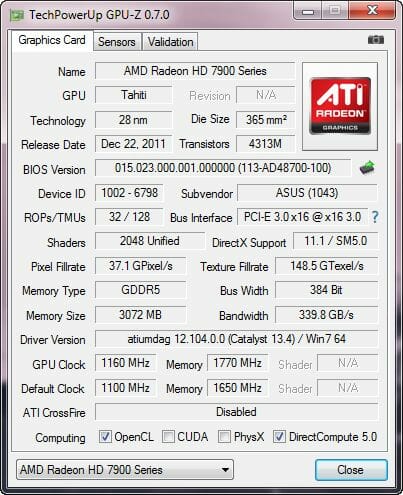
Increasing the GPU voltage to 1.3 volts helped raise the clock rate to 1220 MHz only, so we gave up further attempts to overclock at higher voltages. We may have been unlucky or maybe the card really needed even more voltage. Tweaking the VDDCI parameter didn’t help, either. After increasing the memory voltage to 1.7 volts we reached 7340 MHz without any stability issues or image artifacts.
The card’s temperature didn’t change much when we overclocked it to 1160/7080 MHz without increasing its voltages. The GPU grew 3°C hotter and the fans sped up by 180 RPM.
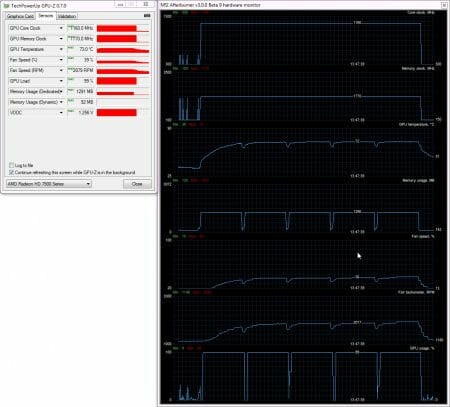
Overclocked to 1220/7340 MHz with increased voltage, the GPU would get as hot as 78°C. The cooler’s fans rotated at 2600 RPM.
Power Consumption
We measured the power consumption of our testbed equipped with different graphics cards using a multifunctional Zalman ZM-MFC3 panel which can report how much power a computer (without the monitor) draws from a wall outlet. There were two test modes: 2D (editing documents in Microsoft Word or web surfing) and 3D (four runs of the introductory “Swamp” scene in Crysis 3 game at 2560×1440 with maximum image quality settings, but without MSAA).
We are going to compare the power consumption of ASUS ROG MATRIX 7970 with that of HIS 7970 IceQ X² GHz Edition, ASUS GeForce GTX 680 DirectCU II TOP and NVIDIA GeForce GTX TITAN:
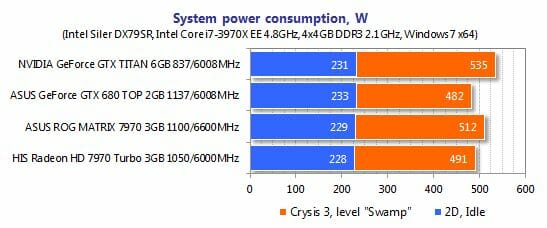
The ASUS ROG MATRIX 7970 system needs a little more power than the system with the HIS Radeon HD 7970 GHz Edition. The difference is only 20 watts at peak load. The overclocked GeForce GTX 680 from ASUS needs 10 watts less than the HIS-based configuration whereas the Nvidia GeForce GTX Titan turns out to be economical and consumes only 23 watts more than the ASUS ROG Matrix 7970 configuration. By the way, notwithstanding ASUS’s recommendations, a computer with ASUS ROG Matrix 7970 can be powered by a 550-600-watt PSU even if it’s got a well-overclocked CPU.
Testbed Configuration and Testing Methodology
All participating graphics cards were tested in a system with the following configuration:
- Mainboard: Intel Siler DX79SI (Intel X79 Express, LGA 2011, BIOS 0559 from 03/05/2013);
- CPU: Intel Core i7-3970X Extreme Edition, 3.5/4.0 GHz (Sandy Bridge-E, C2, 1.1 V, 2 x 256 KB L2, 15 MB L3);
- CPU cooler: Phanteks PH-TC14PE (2 x Corsair AF140 fans at 900 RPM);
- Thermal interface: ARCTIC MX-4;
- Graphics cards:
- ASUS GeForce GTX 680 DirectCU II TOP 2 GB (GTX680-DC2T-2GD5);
- HIS 7970 IceQ X² GHz Edition;
- NVIDIA GeForce GTX TITAN 6 GB;
- System memory: DDR3 4 x 4GB Mushkin Redline (Spec: 2133 MHz / 9-11-10-28 / 1.65 V);
- System drive: Crucial m4 256 GB SSD (SATA-III,CT256M4SSD2, BIOS v0009);
- Drive for programs and games: Western Digital VelociRaptor (300GB, SATA-II, 10000 RPM, 16MB cache, NCQ) inside Scythe Quiet Drive 3.5” HDD silencer and cooler;
- Backup drive: Samsung Ecogreen F4 HD204UI (SATA-II, 2 TB, 5400 RPM, 32 MB, NCQ);
- System case: Antec Twelve Hundred (front panel: three Noiseblocker NB-Multiframe S-Series MF12-S2 fans at 1020 RPM; back panel: two Noiseblocker NB-BlackSilentPRO PL-1 fans at 1020 RPM; top panel: standard 200 mm fan at 400 RPM);
- Control and monitoring panel: Zalman ZM-MFC3;
- Power supply: Corsair AX1200i 1200 W (with a default 120 mm fan);
- Monitor: 27” Samsung S27A850D (DVI-I, 2560×1440, 60 Hz).
Let me remind you what the today’s opponents of the Asus ROG MATRIX 7970 look like:
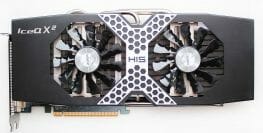
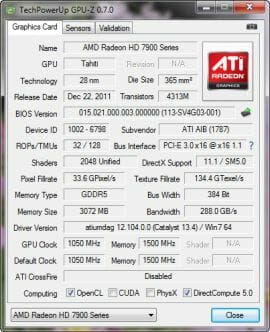
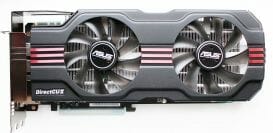
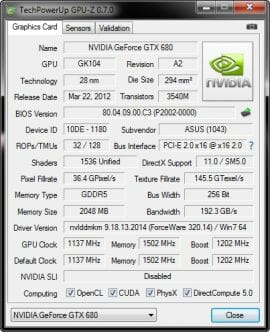
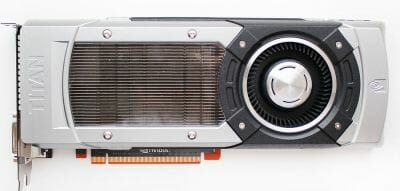
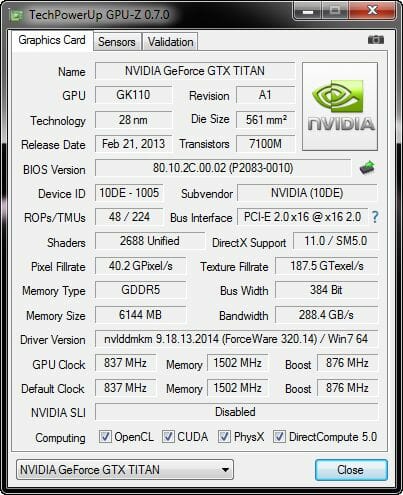
In order to lower the dependence of the graphics cards performance on the overall platform speed, I overclocked our 32 nm six-core CPU with the multiplier set at 48x, BCLK frequency set at 100 MHz and “Load-Line Calibration” enabled to 4.8 GHz. The processor Vcore was increased to 1.38 V in the mainboard BIOS:
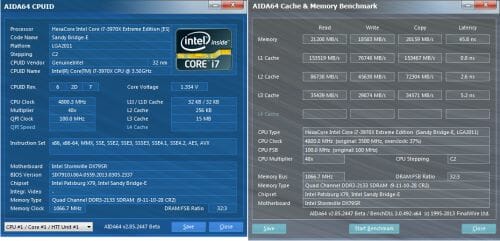
Hyper-Threading technology was enabled. 16 GB of system DDR3 memory worked at 2.133 GHz frequency with 9-11-10-28 timings and 1.65V voltage.
The test session started on May 16, 2013. All tests were performed in Microsoft Windows 7 Ultimate x64 SP1 with all critical updates as of that date and the following drivers:
- Intel Chipset Drivers 9.4.0.1017 WHQL from 03/27/2013 for the mainboard chipset;
- DirectX End-User Runtimes libraries from November 30, 2010;
- AMD Catalyst 13.4 driver from 04/24/2013 + Catalyst Application Profiles 13.4 (CAP1) for AMD based graphics cards;
- Nvidia GeForce 320.14 driver from 05/13/2013 for Nvidia based graphics cards.
We tested the graphics cards performance in two resolutions: 1920×1080 and 2560×1440. The tests were performed in two image quality modes: “Quality+AF16x” – default texturing quality in the drivers with enabled 16x anisotropic filtering and “Quality+ AF16x+MSAA 4x(8x)” with enabled 16x anisotropic filtering and full screen 4x or 8x antialiasing, in those cases when the average fps rate remained high enough for comfortable gaming experience. We enabled anisotropic filtering and full-screen anti-aliasing from the game settings. If the corresponding options were missing, we changed these settings in the Control Panels of Catalyst and GeForce drivers. We also disabled Vsync there. There were no other changes in the driver settings.
Since we have already tested all the graphics cards participating in our today’s review, we used a shorter list of benchmarks today. We only ran the most resource-consuming contemporary benchmarks and games and also included anew game called Metro: Last Light. As a result, our benchmarking suite includes two popular semi-synthetic benchmarks and 10 resource-consuming games of various genres:
- 3DMark 2013 (DirectX 9/11) – version 1.0, benchmarks in “Cloud Gate”, “Fire Strike” and “Fire Strike Extreme” scenes;
- Unigine Valley Bench (DirectX 11) – version 1.0, maximum image quality settings, AF16x and(or) MSAA 4x, 1980×1080 resolution;
- Metro 2033: The Last Refuge (DirectX 10/11) – version 1.2, maximum graphics quality settings, official benchmark, “High” image quality settings; tesselation, DOF and MSAA4x disabled; AAA aliasing enabled, two consecutive runs of the “Frontline” scene;
- Total War: Shogun 2: Fall of the Samurai (DirectX 11) – version 1.1.0, built-in benchmark (Sekigahara battle) at maximum graphics quality settings and enabled MSAA 8x in one of the test modes;
- Battlefield 3 (DirectX 11) – version 1.4, all image quality settings set to “Ultra”, two successive runs of a scripted scene from the beginning of the “Going Hunting” mission 110 seconds long;
- Sniper Elite V2 Benchmark (DirectX 11) – version 1.05, we used Adrenaline Sniper Elite V2 Benchmark Tool v1.0.0.2 BETA with maximum graphics quality settings (“Ultra” profile), Advanced Shadows: HIGH, Ambient Occlusion: ON, Stereo 3D: OFF, two sequential test runs;
- Sleeping Dogs (DirectX 11) – version 1.5, we used Adrenaline Sleeping Dogs Benchmark Tool v1.0.2.1 with maximum image quality settings, Hi-Res Textures pack installed, FPS Limiter and V-Sync disabled, two consecutive runs of the built-in benchmark with quality antialiasing at Normal and Extreme levels;
- Hitman: Absolution (DirectX 11) – version 1.0.446.0, built-in test with Ultra image quality settings, with enabled tessellation, FXAA and global lighting;
- Crysis 3 (DirectX 11) – version 1.0.1.3, all graphics quality settings at maximum, Motion Blur amount – Medium, lens flares – on, FXAA and MSAA4x modes enabled, two consecutive runs of a scripted scene from the beginning of the “Swamp” mission 110 seconds long;
- Tomb Raider (2013) (DirectX 11) – version 1.1.743.0, we used Adrenaline Benchmark Tool, all image quality settings set to “Ultra”, V-Sync disabled, FXAA and 2x SSAA antialiasing enabled, TessFX technology activated, two consecutive runs of the benchmark built into the game;
- BioShock Infinite (DirectX 11) – version 1.1.21.26939, we used Adrenaline Action Benchmark Tool v1.0.2.1, two consecutive runs of the built-in benchmark with “Ultra” and “Ultra+DOF” quality settings.
- Metro: Last Light (DirectX 11) – version 1.0.2, we used built-in benchmark for two consecutive runs of the D6 scene. All image quality and tessellation settings were at “Very High”, “Advanced PhysX technology was enabled, we tested with and without SSAA antialiasing.
If the game allowed recording the minimal fps readings, they were also added to the charts. We ran each game test or benchmark twice and took the best result for the diagrams, but only if the difference between them didn’t exceed 1%. If it did exceed 1%, we ran the tests at least one more time to achieve repeatability of results.
Performance
3DMark (2013)
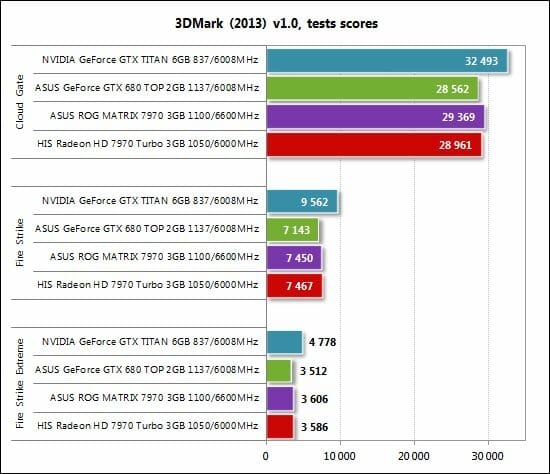
We can see the same picture in each of the three tests from the latest version of 3DMark. The GeForce GTX Titan is expectedly in the lead, followed by the two Radeons from HIS and ASUS. The latter is just a little faster than the HD 7970 GHz Edition, so the extra 50 MHz of GPU clock rate and extra 600 MHz of graphics memory frequency are not very beneficial. On the other hand, the Radeons are both ahead of the factory-overclocked GeForce GTX 680 from ASUS, which is actually one of the fastest GTX 680s available.
Unigine Valley Bench
This benchmark shows us a different picture:
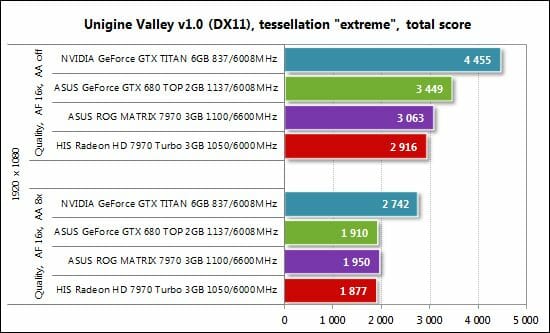
The GeForce GTX series cards leave no chance to their AMD-based opponents when full-screen antialiasing is not enabled. But as soon as we turn on 8x MSAA, only the GeForce GTX Titan remains in the lead while the ASUS GeForce GTX 680 DirectCU II TOP is challenged by the Radeon HD 7970 GHz Edition cards.
Metro 2033: The Last Refuge
We’ll benchmark our cards in the recently released Metro: Last Light at the end of this review, but right now let’s see what we have in the previous game of the series:
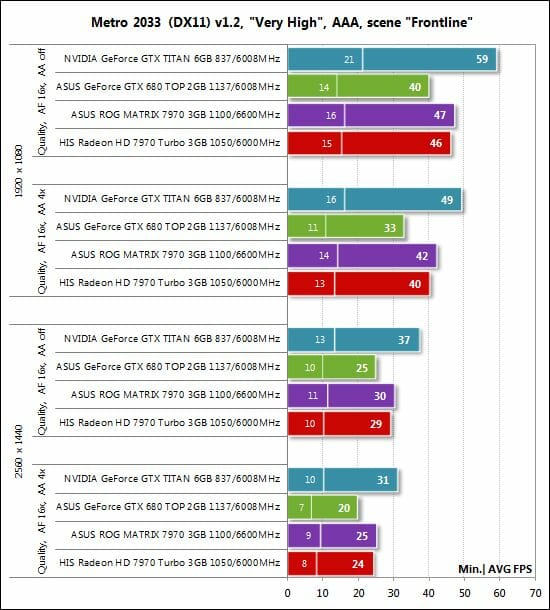
There’s a gap between the Nvidia GeForce GTX Titan and the other three cards, but the Radeon HD 7970s are both faster than the factory-overclocked GeForce GTX 680. The ASUS ROG MATRIX 7970 is 2-3% ahead of the HIS 7970 IceQ X² GHz Edition here.
Total War: Shogun 2 – Fall of the Samurai
The standings are different in this game:
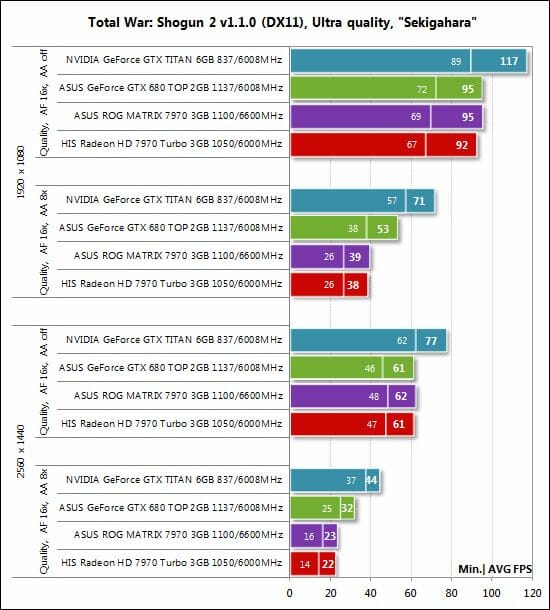
Excepting the Titan, the three fastest single-GPU graphics cards deliver the same average and bottom frame rates when antialiasing is off. But when we use 8x MSAA, the GeForce GTX 680 goes ahead, so the bottom frame rate with the GTX 680 equals the average frame rate with the HD 7970 GHz Edition cards.
Battlefield 3
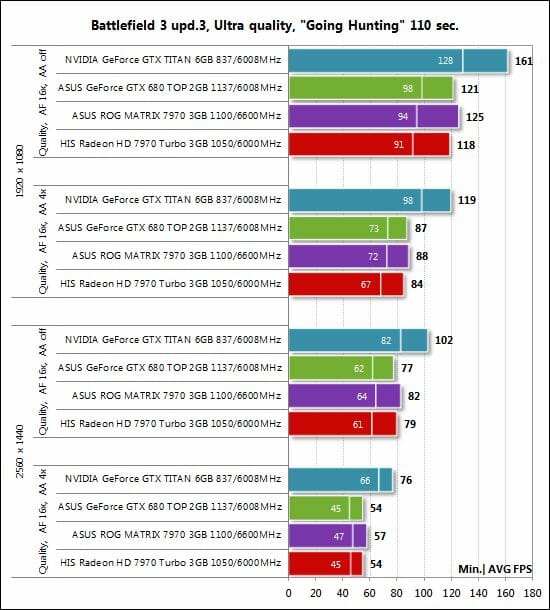
Again excepting the Titan, the three other cards are roughly the same in this game, delivering identical average and bottom frame rates. The ASUS is just 2 or 3% ahead of the HIS.
Sniper Elite V2 Benchmark
We can see the same picture in this benchmark, too:
Sleeping Dogs
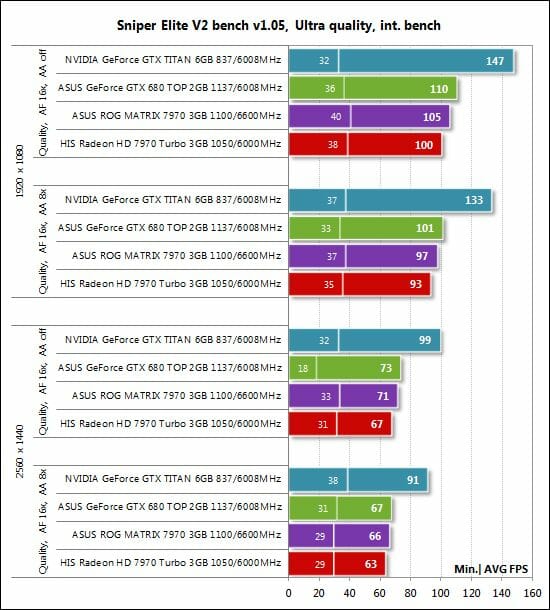
The AMD-based cards are preferable in this game. The Radeon HD 7970, particularly in the ASUS ROG Matrix 7970 version, can challenge the GeForce GTX Titan here, although the difference in price between them equals the price of a Radeon HD 7950 or a GeForce GTX 670!
Hitman: Absolution
We’ve got interesting results in this game:
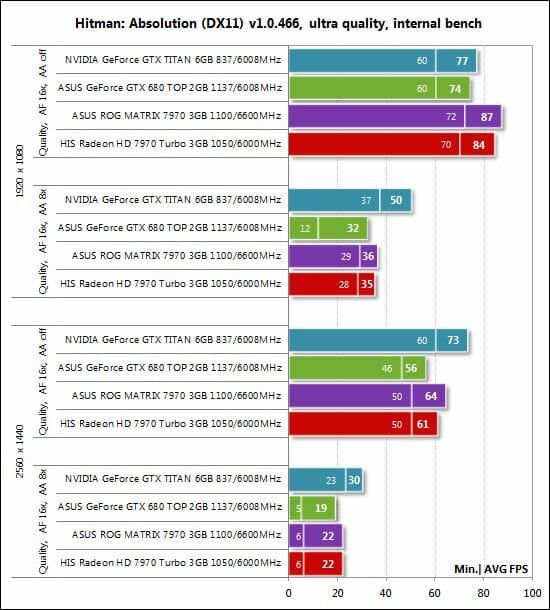
The two Radeons are superior at the easiest settings but the GeForce GTX Titan wins elsewhere, just as expected. The AMD-based cards from ASUS and HIS beat the Nvidia-based ASUS here.
Crysis 3
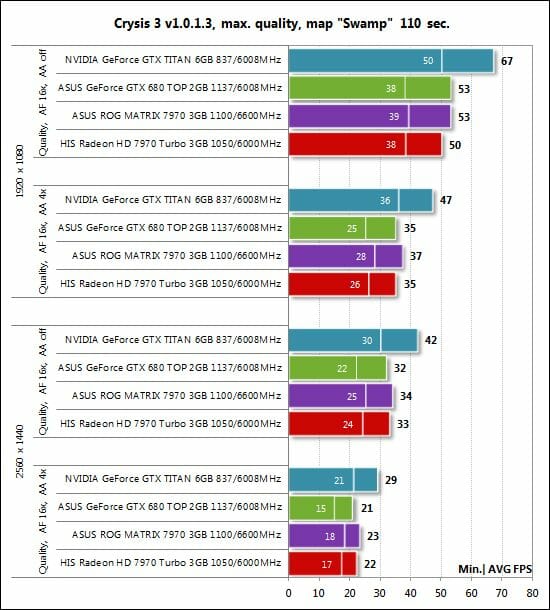
The Crysis 3 results agree with the overall picture of the relative performance of these graphics cards.
Tomb Raider (2013)
We can see the same in Tomb Raider:
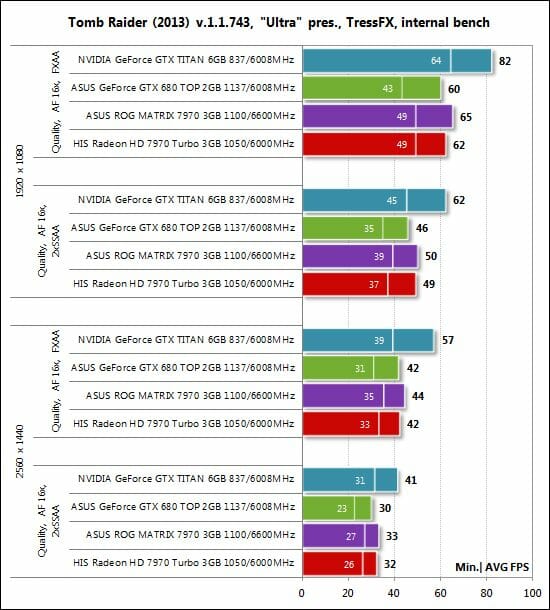
BioShock Infinite
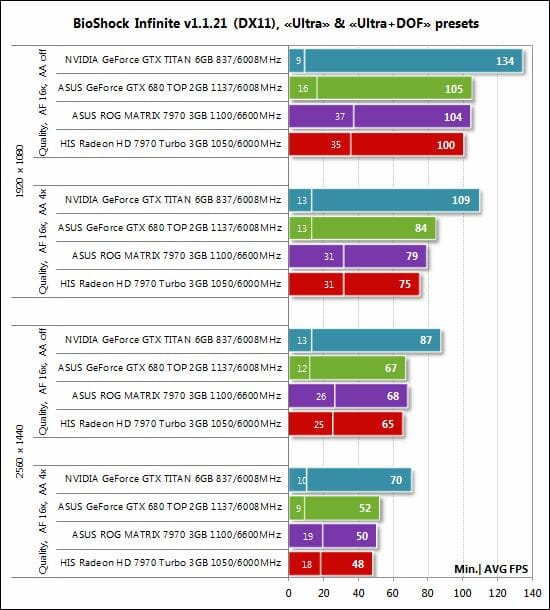
BioShock Infinite has a very low bottom speed on the Nvidia-based cards although their average frame rate is okay. The ASUS GeForce GTX 680 DirectCU II TOP is competing successfully with the HIS 7970 IceQ X² GHz Edition as well as with the slightly faster ASUS ROG Matrix 7970.
Metro: Last Light
We ran this game with the following visual quality settings:
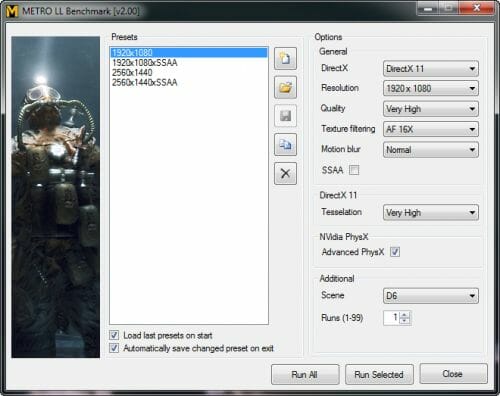
Here are the results:
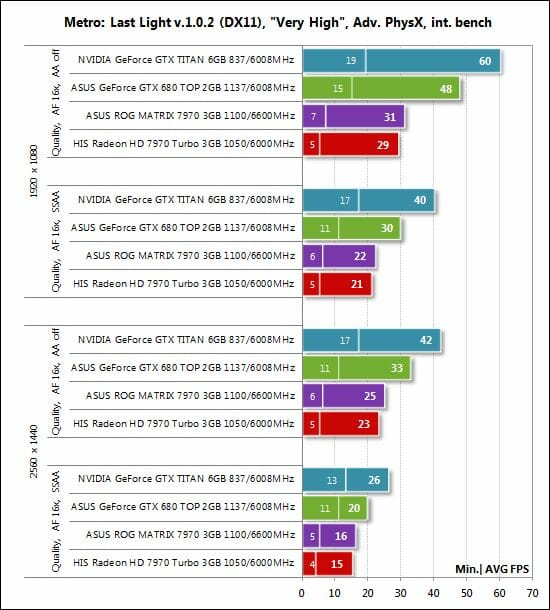
The Nvidia-based products are superior, the GeForce GTX 680 enjoying a large advantage over the Radeon HD 7970 GHz Edition. Let’s also check out their speed with Advanced PhysX turned off:
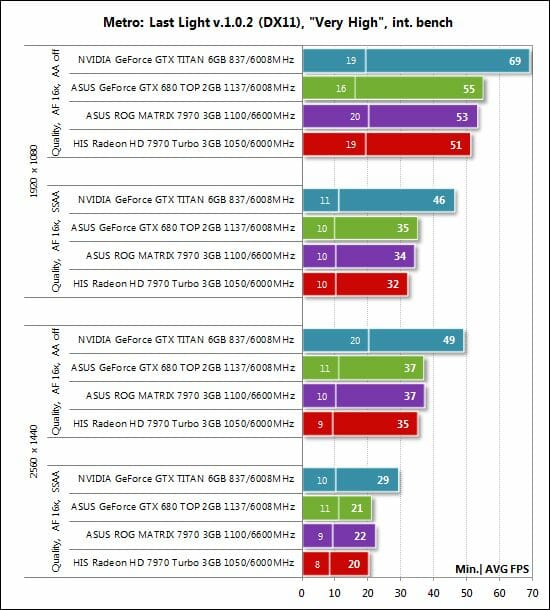
As you can see, the Radeon HD 7970 series cards feel much better in this game without Advanced PhysX, becoming competitive against the GeForce GTX 680. The ASUS ROG Matrix 7970 is 2-3% faster than the HIS 7970 IceQ X² GHz Edition while the GeForce GTX Titan remains an unrivalled leader.
Here is a table with full test results:
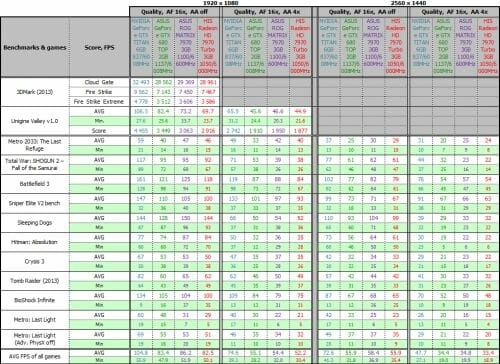
Conclusion
The ASUS ROG Matrix 7970 is not just the fastest AMD-based single-GPU graphics card. It is a functional and feature-rich tool that can serve you to achieve record-breaking performance in various tests and benchmarks. The Choice of Champions slogan is applied to this graphics card most appropriately. It does offer infinite capabilities for champion overclockers.
It features a 20-phase power system with Super Alloy Power technology. It lets you adjust all voltages. It supports full-featured monitoring of each parameter via the VGA Hotwire interface. It is equipped with a highly efficient cooler with a special max-speed mode. It has a replaceable heatsink on its power components for better cooling. And it supports up to six monitors concurrently.
Added to these are the informative highlighting of the DirectCU II cooler, the GPU Tweak utility, the premium packaging with rich accessories, and a 3-year warranty. We couldn’t find even a single flaw in its design, so we recommend the ASUS ROG Matrix 7970 to every overclocker who wants to set new performance records.
That said, we are proud to award ASUS ROG Matrix 7970 our Editor’s Choice title:
